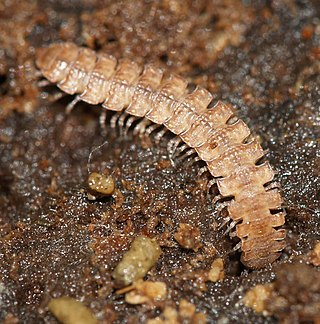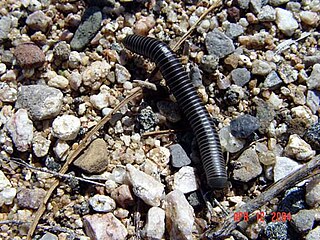
Millipedes are a group of arthropods that are characterised by having two pairs of jointed legs on most body segments; they are known scientifically as the class Diplopoda, the name derived from this feature. Each double-legged segment is a result of two single segments fused together. Most millipedes have very elongated cylindrical or flattened bodies with more than 20 segments, while pill millipedes are shorter and can roll into a tight ball. Although the name "millipede" derives from Latin for "thousand feet", no species was known to have 1,000 or more until the discovery in 2020 of Eumillipes persephone, which can have over 1,300 legs. There are approximately 12,000 named species classified into 16 orders and around 140 families, making Diplopoda the largest class of myriapods, an arthropod group which also includes centipedes and other multi-legged creatures.

Chilognatha is a subclass of the class Diplopoda, which includes the vast majority of extant millipedes, about 12,000 species.

Spirobolida is an order of "round-backed" millipedes containing approximately 500 species in 12 families. Its members are distinguished by the presence of a "pronounced suture that runs "vertically down the front of the head". Most of the species live in the tropics, and many are brightly coloured. Mature males have two pairs of modified legs, the gonopods, consisting of the 8th and 9th leg pair: the posterior gonopods are used in sperm-transfer while the anterior gonopods are fused into a single plate-like structure.

Spirobolidae is a family of millipedes in the order Spirobolida. The family consists of several genera with numerous species, and is commonly divided into the subfamilies Spirobolinae and Tylobolinae.

Sphaerotheriida is an order of millipedes in the infraclass Pentazonia, sometimes known as giant pill millipedes. They inhabit Southern Africa, Madagascar, South and Southeast Asia, Australia and New Zealand. Like the Northern Hemisphere pill millipedes of the order Glomerida, these millipedes can roll into a ball when disturbed. When they are rolled-up, most sphaerotheriidans reach a maximum size of a cherry or golf ball, but some species from Madagascar can even reach the size of an orange. When rolled-up, predators are unable to unravel giant pill millipedes since the margins of their second and last dorsal plates fit perfectly into one another, creating a sealed ball. A few giant pill millipede species are able to produce sound, the only millipedes known to do this. This order of millipedes is also unique in that some African species are used for medicinal purposes.

Sphaeromimus, or the chirping giant pill millipedes, is a genus of giant pill millipedes endemic to southeastern Madagascar. Though described in 1902, the genus was up to 2005 known from a single male specimen, whose appearance was so unusual that the authors suspected a mislabeled giant pill-millipede from India. Their unusual and distinct morphology includes well-developed stridulation organs, probably as devices for courtship. These are the male ‘harp’ and the female ‘washboard’, which contain more stridulation ribs than in other members of the order Sphaerotheriida. They have a closer affinity with the Indian genus Arthrosphaera than to other Malagasy genera, though all belong to the Arthrosphaeridae.

Xystodesmidae is a family of millipedes in the suborder Leptodesmidea within the order Polydesmida. The family Xystodesmidae was created by the American biologist Orator F. Cook in 1895 and named after the genus Xystodesmus. This family includes more than 390 known species distributed among 62 genera. Many species, however, remain undescribed: for example, it is estimated that the genus Nannaria contains over 200 species, but only 25 were described as of 2006. By 2022, 78 species in Nannaria have been described.

Zephroniidae is a family of giant pill millipedes in the taxonomic order Sphaerotheriida. They occur in southeast Asia from the Himalayas and China south and east to Sulawesi and to Australia, and also inhabit some Philippine islands.

Polyzoniida is an order of millipedes in the subterclass Colobognatha. This order contains three families and more than 70 described species. The species in this order are also known as camphor millipedes, because ozopore secretions in this order frequently have a strong camphor-like smell. Poison frogs in South America and Madagascar evidently obtain some of their poison from these millipedes.

Tylobolus is a genus of millipedes in the order Spirobolida with seven known species found in western North America. It is in the family Spirobolidae, and is the type genus of the subfamily Tylobolinae. The genus was named by Orator F. Cook in 1904.

Harold Frederick Loomis was an American botanist and myriapodologist known for his contributions to agronomy, plant pathology, and millipede taxonomy. He worked for the U.S. Department of Agriculture for over four decades, studying diseases of crop plants, and was a colleague of Orator F. Cook. He also made major contributions to the natural history of Central America and the West Indies, naming over 500 species of millipedes in total. He co-described with Cook the leggiest animal on earth: Illacme plenipes, with over 700 legs.

Casimir Albrecht Willem Jeekel (1922–2010) was a Dutch myriapodologist and entomologist known for his major contributions to the taxonomy of millipedes. His 1971 monograph Nomenclator Generum et Familiarum Diplopodorum is credited as launching the "modern era" of millipede taxonomy, and has been considered the "most important single work ever published on the Diplopoda". He served as director of the Zoological Museum Amsterdam, and authored over 150 works on the taxonomy of millipedes and other myriapods.
Floridobolus is a genus of millipedes commonly known as Florida scrub millipedes containing three described species: Floridobolus penneri, F. orini, and F. floydi; the latter two described in 2014. All three species are endemic to Florida scrub habitat of peninsular Florida, and F. penneri is considered a critically imperiled species by NatureServe. Prior to the description of F. orini, the genus was considered the sole member of the family Floridobolidae, named by William T. Keeton in 1959, however studies in 2014 have argued that Floridobolus does not represent a distinct family but rather is a basal member of the family Spirobolidae, representing the subfamily Floridobolinae, and tribe Floridobolini.

Juliformia is a taxonomic superorder of millipedes containing three living orders: Julida, Spirobolida, and Spirostreptida, and the extinct group Xyloiuloidea known only from fossils.
Siphonotidae is a family of millipedes in the order Polyzoniida. This family includes more than 70 species distributed among 13 genera. These millipedes are found in South America, South Africa, Madagascar, Southeast Asia, and New Zealand. Millipedes in this family have a narrow telson and are quick and active.

Atopetholidae is a family of millipedes in the order Spirobolida. There are about 18 genera and at least 60 described species in Atopetholidae.
Allopocockiidae is a family of millipedes in the order Spirobolida. There are about five genera and eight described species in Allopocockiidae.

Spirobolellidae is a family of millipedes in the order Spirobolida. There are about 11 genera and more than 100 described species in Spirobolellidae.
Dorypetalidae is a family of millipedes in the order Callipodida. The family contains at least 4 genera and about 10 species.
Spiromimus is a genus of millipedes in the family Pachybolidae. They mostly live in rainforests and dry land.














